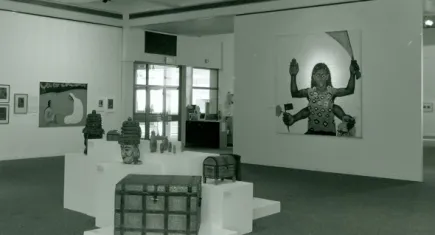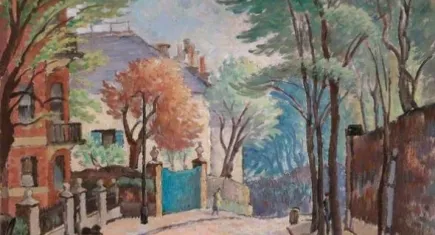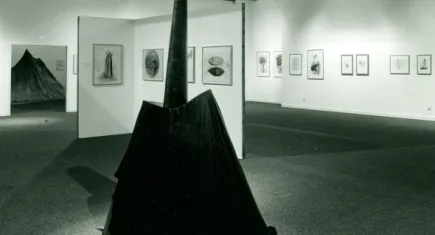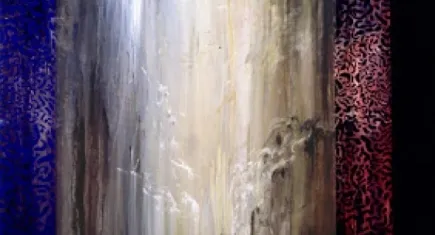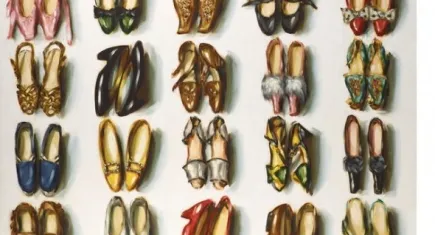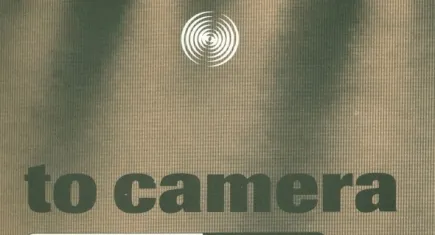Mead Gallery Exhibitions 1993
Cadences of the Heart: Works from South Asia in British Collections
A Mead Gallery Exhibition in collaboration with Bradford Art Gallery and Museum
Sat 20 Nov – Sat 18 Dec 1993
This exhibition explores the ways in which images and ideas present in South Asian paintings, textiles and ceramics are reworked and re-examined. It includes examples of eighteenth century calligraphy, nineteenth century textiles and ceramics, paintings, prints and sculptures by contemporary artists such as Bhupen Khakhar, Dhruva Mistry and Shanti Panchal.
For Public Pleasure
A Mead Gallery Exhibition
Sat 20 Nov – Sat 18 Dec 1993
Twentieth Century British Paintings from the Collections of Rugby Borough Council and Sheffield City Council
Following the success of the Great Exhibition in 1851, most British cities felt impelled to build public museum and art galleries for the education and enjoyment of their citizens and to acquire contemporary works of art to fill them.
This exhibition provides the opportunity to compare some of the works in the civic collections of Sheffield and Rugby and to examine the policies and personalities behind the acquisition of paintings by distinguished British artists, including Stanley Spencer and Christopher Wood.
Recent British Sculpture from the Arts Council Collection
A National Touring Exhibition organised by the Southbank Centre for Arts Council of Great Britain
Sat 9 Oct – Sat 13 Nov 1993
During the 1980s, the work of many British sculptors received international acclaim. Suddenly, sculpture was viewed as the principal arena for artistic experimentation as traditional assumptions about the nature of sculptural forms were challenged and reworked.
This exhibition brings together the work of 22 young sculptors, all of whom work and exhibit in an international context. Some of the materials and techniques used recall traditional approaches such as the carved wood of Stephen Hughes’ ‘Container 1’ or the cast bronze of Veronica Ryan’s ‘Territorial’. However, in common with the other sculptors who use new materials such as plastics, ready-made objects and electricity, they create abstract forms, narratives and images that evoke a range of references and experiences which offer insight into worlds parallel with our own. The exhibition includes work by Tony Cragg, Richard Deacon, Anish Kapoor, Cornelia Parker, Kathy Prendergast and Bill Woodrow.
The exhibition is shared with the Herbert Art Gallery in Coventry’s city centre.
Sponsored by British Telecom
The Body of Drawing: Drawings by Sculptors
A National Touring Exhibition organised by Southbank Centre for the Arts Council of Great Britain
Sat 9 Oct – Sat 13 Nov 1993
For many sculptors, drawing is the starting point of an idea. For others, it is also a statement in itself. The focus of this exhibition is the work of those artists who used drawing for its own sake; seeing it as a parallel activity to the rest of their work. In some instances, artists have shifted the boundaries of the concept of drawing, stressing the material aspects of the media through their use of both traditional and non-traditional materials.
The exhibition offers the rare opportunity to see drawings by international artists such as Joseph Beuys, Louise Bourgeois, Jonathan Borofsky, Eduardo Chillida and Antony Gormley.
Sponsored by British Telecom
Accumulations
Exhibition organised and toured by Stoke on Trent City Museum and Art Gallery
Sat 12 Jun – Sat 10 Jul 1993
The final art collection to be brought to the Mead Gallery this season is from Stoke on Trent. Artist Terry Shave has chosen works from the City Museum’s art stores and juxtaposed them with his own paintings to reflect his own artistic concerns and reveal the Museum’s collections in a new light.
Paintings by Lisa Milroy and John Murphy
A Mead Gallery Exhibition
Sat 1 May – Sat 5 June 1993
Introducing Craft: Works from the Crafts Council Collection
A Mead Gallery Exhibition
Tue 18 May – Sat 10 Jul 1993
Curated by the Mead Gallery, this exhibition brings together over 50 works from the Crafts Council Collection which examine the development of craft from an exposition of “craftsmanship” and an exploration of the potential of different materials to works that prioritise sculptural forms over functional use.
To Camera: Light, Action, Sound
Organised and toured by Film and Video Umbrella
Sat 1 May – Sat 8 May 1993
To Camera is a programme of artists’ films that charts the links between video and performance art across more than two decades. It maps the history of this genre through three separate programmes structured around the themes of ‘light’, ‘action’ and ‘sound’.
Countervail: Nicole Charlett, Elizabeth Chaplin, Judith Dean, Natalie Dower, Tam Giles, Jean Spencer, Susan Tebby, Jane Wilbraham
The impetus for this exhibition came from research by sociologist Elizabeth Chaplin into how the viewer relates to different works of art and how changes in setting can affect this relationship. The artists here are concerned with issues of gender and feminism and the exhibition is one of a series of three that examines the work of women artists. The second exhibition in this series, (dis)parities which looks specifically at abstract paintings made by women is also on view at the Herbert Art Gallery in Coventry from 27 February to 18 April 1993.
Following this exhibition, the artist Jean Spencer bequeathed two works to the University of Warwick in 1998.
Obituary for Jean Spencer
Michael Harrison, Curator Kettle’s Yard, University of Cambridge
The Independent, Wednesday 28 January 1998
Jean Mary Spencer, artist and educator: born Frimley, Surrey 22 April 1942; married Malcolm Hughes 1997 (died 1997); died London 4 January 1998.
For many artists in the more liberal Sixties and Seventies teaching was the lifeline which financed studio practice but for Jean Spencer a commitment to both was there from the outset. At Bath Academy of Art (1960-63), then in Corsham, she took a teacher training course in art instead of straight fine art. She then went on to teach at Bulmershe College of Higher Education in Reading (1968-88), before a 10-year stint at the Slade School of Fine Art as Tutor to Students and Secretary to the School, and, from 1995, also as Reader in Fine Art.
In the sixth form she had decided that art was for her, and her other A level subjects, maths and literature, remained of almost equal importance throughout her life. Her artistic path was decided in her second year at Bath when Malcolm Hughes and John Ernest, as tutors, introduced her to the world of systematic constructivism, with which she engaged immediately. The labels of that kind of art would change, as would her work, over the next 35 years, but for the rest of her life hers was to be an abstract constructive art, founded in rationality and in strong egalitarian conviction.
The early works were white reliefs, often articulated by numerical sequences, but in the mid-Seventies she became interested in colour because, as she said, “there comes a point when the sorts of things that you want to say about how something relates to something else . . . become extremely complex”. Painting was a matter of dealing with a question or a problem whose answer would be found in pictorial resolution.
In a recent interview she talked about a four-part set of paintings made in 1992: “I wanted to deal with deep violet as a problem and make a painting which starts with that deep violet.” Those paintings were of equal, ‘egalitarian’ bands, but more recently she played, against all constructivist orthodoxy, with our tendency to seek an object and a ground and with the interchange between the two:
“I wanted certain boundaries to be seen as though under dispute; I wanted colour alignments to countervail geometric divisions; I wanted an asymmetry of composition to offer, perhaps, some resolution to the asymmetries inherent in the colour array; and all this ‘legally’ that is within a system against which individual judgements can be made.”
The cerebral and the emotional were as important as each other and she was acutely aware that, while her paintings involved the detachment of rules or systems, they drew life from the contingencies of fleeting light and the active collaboration of the people looking at them. “You only get interest out if you invest!” she remarked.
Collaboration and exchange were always important. Spencer was the youngest member of the Systems group whose activities reached their climax in an Arts Council touring exhibition, first shown at the Whitechapel in 1972.
What she saw as “an ideal kind of collaboration” came about from 1983 when Ray Thomson’s Whitechapel studio would be converted each month into Exhibiting Space where artists, architects, theoreticians, historians, linguists, musicians et al would gather in an attempt to break down the barriers between art practice and art theory and to explore connections with other disciplines.
Spencer’s egalitarian commitment led naturally to feminism and to ardent support for other women artists. It was she who came up with the title Countervail, adopted from Julia Kristeva’s 1972 essay “Giotto’s Joy”, for a grouping of women artists which had sprung out of interviews with the sociologist Elizabeth Chaplin. They took issue with the mainstream feminist position that all forms of rationality were antipathetic to women. As Spencer confessed, “I don’t think at any point we came to a comfortable solution to that”, but discussions led on to her initiating a “Postal Academy”, and to a successful series of exhibitions and seminars in Sheffield, and at Warwick and York Universities.
Organised and toured by the Mappin Art Gallery, Sheffield
Sat 20 Feb – Sat 20 Mar 1993
Spencer was the epitome of the artist-researcher, always curious and enquiring, and invariably bubbling with the excitement of some new connection found. In 1978-79 she took time out to do an MA in the History and Theory of Art at Sussex University and is remembered as a student of daunting intelligence and depth. She read and re-read Proust, loved Bach, and found interest in early narrative opera, particularly Handel. That engagement with narrative and with time in its apprehension formed a major part of a study of Giotto’s Arena chapel which was far advanced but incomplete when she died. All this fed into her painting.
It is some achievement to have got this far having mentioned Malcolm Hughes only once. The tutor became partner and eventually husband, and theirs was one of those remarkable artistic partnerships which allowed each their independence, and whose kitchen in Putney, south-west London, was second home for many an artist and musician. They shared a passion for bicycles and for his 70th birthday Jean offered Malcolm a trip to a place of his choice to see the Tour de France. A few years later they cycled the breadth of England, admittedly at its narrowest, but probably its hilliest point, ending up at Durham Cathedral.
Jean’s death was a tragic sequel to that of Malcolm, also from cancer, in September 1997. Over the previous five years and more they had been the driving force and vision behind a project which led to the exhibition “Testing the System” at Kettle’s Yard in Cambridge, followed by a symposium, “Patterns of Connection”, and an exhibition of the paintings of Richard Paul Lohse. Their last summer was spent with Jean, for once free of educational duties, as Kettle’s Yard Artist Fellow at Churchill College, and Malcolm in attendance.
The last blue area of the six paintings which Jean Spencer made in Cambridge, was applied according to her instruction by Trevor Clark in the week before she died.
Flora Photographica: Masterpieces of Flower Photography
Organised and toured by the Southbank Centre, London
Sat 23 Jan – Sat 6 Mar 1993
The still life was an obvious subject for early experiments in photography in the mid 19th century and flowers have remained an interest for photographers ever since. This exhibition surveys a variety of approaches to this subject by photographers working from the 1850s to the present. Images of pioneering photographers including Julia Margaret Cameron and Fox Talbot will be shown alongside works by twentieth century pioneers including Cecil Beaton, Mari Mahr, Robert Mapplethorpe, Man Ray, John Stezaker and Edward Weston.
Exhibition sponsored by British Telecom
Peter Lanyon: Air, Land and Sea
Organised and toured by the Southbank Centre, London in collaboration with Camden Arts Centre
Mon 11 Jan – Sat 13 Feb 1993
Born in 1918, Peter Lanyon was inspired by the landscape of his native Cornwall. This exhibition illuminates the working method of this major British artist who died in a gliding accident in 1964. The exhibition features twenty rarely seen constructions with related paintings and drawings which span his career.
“I paint the weather and high places and the places where solids and fluids meet. The junction of sea and cliff, wind and cliff, the human body and places all contribute to this concern.” Peter Lanyon, 1962
Exhibition sponsored by British Telecom

